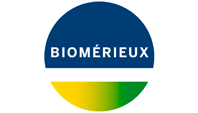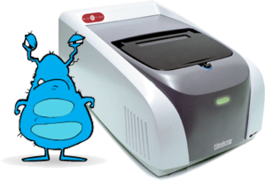FILMARRAY™ Respiratory Panel
Respiratory Panel for FILMARRAY™ multiplex PCR system
The FILMARRAY™ Respiratory Panel enables rapid and accurate automated detection of pathogens behind respiratory infections. It tests for 17 viruses and 3 bacteria which cause upper respiratory tract infections with an overall sensitivity and specificity of 95% and 99% respectively.
- Simple: 2 minutes of hands-on time
- Easy: No precise measuring or pipetting required
- Fast: Turnaround time of about an hour
- Comprehensive: 20 target including viruses and bacteria
Do you need more information
Simple, comprehensive respiratory testing
The FILMARRAY Respiratory Panel tests for 17 viruses and 3 bacteria which cause upper respiratory tract infections with an overall sensitivity and specificity of 95% and 99% respectively. It works on the FilmArray™ system, an FDA, CE-IVD, and TGA certified multiplex PCR system.FILMARRAY™ integrates sample preparation, amplification, detection and analysis into one simple system that requires just 2 minutes of hands-on time, with a total run time of about an hour. Rapid and accurate identification of the causative agent of upper respiratory tract infections may improve patient management by informing timely and effective antibiotic or antiviral therapy, preventing secondary spread of infection, shortening hospital stays and reducing costs of unnecessary ancillary tests.
- Simple: 2 minutes of hands-on time
- Easy: No precise measuring or pipetting required
- Fast: Turnaround time of about an hour
- Comprehensive: 20 target respiratory panel
20 targets at once
TheFILMARRAY™ Respiratory Panel is incredibly comprehensive, with simultaneous testing for 20 of the most common pathogens involved in UTRI.
| Viruses | Bacteria | |
|
Adenovirus
Coronavirus 229E
Coronavirus HKU1
Coronavirus OC43
Coronavirus NL63
Human Metapneumovirus
Human Rhinovirus/Enterovirus
Influenza A
|
Influenza A/H1
Influenza A/H1-2009
Influenza A/H3
Influenza B
Parainfluenza 1
Parainfluenza 2
Parainfluenza 3
Parainfluenza 4
RSV
|
Bordetella pertussis
Chlamydophila pneumoniae
Mycoplasma pneumoniae
|
Panel Specification
| Sample Handling | Performance Parameters |
|---|---|
| Sample Type: Nasopharyngeal Swab | Hands-on time: Approx. 2 minutes |
| Sample Volume: 300 μL | Run turnaround time: About an hour |
Clinical Sensitivity and Specificity of the FilmArray Respiratory Pouch
| Pathogen | SENSITIVITY Prospective |
SENSITIVITY Retrospective |
SPECIFICITY Prospective |
|---|---|---|---|
| Adenovirus | 88.9% | 100% | 98.3% |
| Bocavirus | 66.7% | 100% | 99.8% |
| Coronavirus HKU1 | 95.8% | n/a | 99.8% |
| Coronavirus NL63 | 95.8% | n/a | 100% |
| Coronavirus 229E | 100% | n/a | 99.80% |
| Coronavirus OC43 | 100% | n/a | 99.60% |
| Human Metapneumovirus | 94.6% | n/a | 99.2% |
| Human Rhinovirus/Enterovirus | 92.7% | 95.7% | 94.6% |
| Influenza A | 90.0% | n/a | 99.8% |
| Influenza A/H1 | n/a | 100% | 100% |
| Influenza A/H3 | n/a | 100% | 100% |
| Influenza A/H1-2009 | 88.9%* | 100% | 99.6% |
| Influenza B | n/a | 100% | 100% |
| Parainfluenza Virus 1 | 100%* | 97.1% | 99.9% |
| Parainfluenza Virus 2 | 87.4%* | 100% | 99.8% |
| Parainfluenza Virus 3 | 95.8%* | 100% | 99.8% |
| Parainfluenza Virus 4 | 100%* | 100% | 99.9% |
| Respiratory Syncytial Virus | 100% | n/a | 89.1% |
| Bordetella pertussis | 100%* | 100% | 99.90% |
| Chlamydophila pneumoniae | 100%* | n/a | 100% |
| Mycoplasma pneumoniae | 100%* | 90.0% | 100% |
Fast facts on Respiratory Pathogens
What are Respiratory Pathogens?
The vast majority of respiratory illnesses are caused by viruses and bacteria. In both children and adults, acute respiratory infections (ARI) are most frequently due to infections with Influenza A and B viruses, Parainfluenza viruses 1, 2 and 3, Respiratory Syncytial Virus (RSV A and B), Adenoviruses and Rhinoviruses. Others pathogens such as Coronaviruses, Bocaviruses, Enteroviruses, Parainfluenza 4, Human Metapneumovirus, Mycoplasma pneumonia and Chlamydophila pneumoniae also infect the respiratory tract and can cause various diseases from mild self-limiting upper respiratory infections to potentially threatening pneumonia.
Who is most at risk?
Anyone can become infected and ill with these respiratory pathogens. However, young children, the elderly, immunocompromised or weakened individuals (including those with chronic disease, cancer, or in intensive care) are most likely to suffer serious and potentially life-threatening pneumopathies.
What are the benefits of Respiratory pathogens molecular testing?
Clinical symptoms for different respiratory illnesses are similar so in vitro diagnostic molecular methods are necessary to determine the causative agents. Early, rapid and specific detection of the virus or bacteria involved using real-time PCR methods is essential to provide patient-tailored therapy for better outcomes. An accurate diagnosis may also help to control outbreaks, reduce potential antibiotic resistance and facilitate a more rapid patient recovery.



